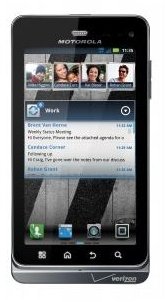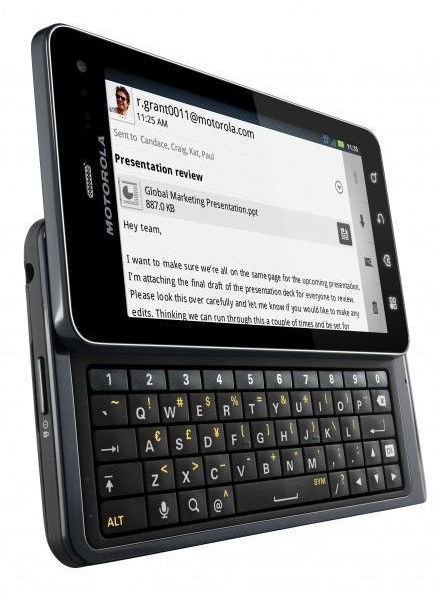The End of the Droid Trilogy - Motorola Droid 3 Reviewed
The Droid Trilogy
The Droid 3 rounds out the trilogy of smartphones from Motorola under the Droid banner. Most movie trilogies have a fantastic 3rd act, rounding out and finishing the climatic story in some amazing manner. The question is, does the Droid 3 also finish off the trilogy in a great way or does it peter out like a movie that had too many hands in the pot at the end? While there’s most likely going to be a 4th Droid in the series, it’s fun to think that the Droid 3 will be the end of this first trilogy from Motorola. While the original Droid was pretty much an amazing launching pad for Verizon, it seems the successors have not had as much success when it comes to marketing. The Droid 3 had a fairly quiet release when compared to its predecessors.
Design and Display (3 out of 5)

The Droid 3 follows many of the design cues from the original Droid and Droid 2. Dominating the front is a 4 inch qHD display, which is larger than the previous Droid smartphones. The display is vibrant and colorful and there’s really no pixilation thanks to the qHD resolution that the display provides. In addition, it also has Gorilla Glass, meaning it’s nearly unscratchable like the Samsung Galaxy S2. It still has the rectangular shape with a small lip jutting out at the bottom of the display. Beneath the display are the four familiar Android shortcuts for menu, home, back and search.
The left edge contains the microUSB and HDMI out port. The right edge contains the volume rocker. Up top is where the power / lock button and 3.5 mm headphone jack reside. Overall a very familiar design, with the HDMI out being a new addition and the power / lock button and 3.5 mm headphone jack being switched. The display can be pushed aside to reveal a large QWERTY keyboard, which is pretty much exactly like the Droid and Droid 2, except it seems to be missing the gold accents, chrome trim and blue tint found on its predecessors.
Performance (4 out of 5)
The Droid 3 is a dual core smartphone, and is preloaded with Android 2.3. It runs smoothly with little to no lag and the once invasive MotoBLUR no longer exists on top of Android; instead it’s a different overlay which is currently nameless. It only adds slight modifications, but it also adds transition animations which can be annoying. Thankfully these transitions can be turned off though.
The call quality was decent with incoming calls coming in clear and outgoing calls having a slight bit of echo, but otherwise decent. The data speeds aren’t disappointing, but they’re not the greatest as it’s not a 4G LTE enabled smartphone like the HTC Thunderbolt. It’s a bit of a mystery as to why the Droid 3 isn’t a 4G LTE smartphone, considering the push that Verizon is having for faster data speeds.
User Interface (4 out of 5)
The user interface on the Droid 3 is definitely better than its predecessors. It features Android 2.3, the latest and greatest version currently in the market. Running on top is a nameless overlay by Android, which is essentially a very light version of MotoBLUR. The touchscreen interface is easy to learn and master and the overlay generally livens up the interface from the mundane stock version of Android. There will be some who prefer stock Android however as it does lead to faster over the air updates of the next Android update.
The keyboard is actually very well built and expands upon an already nice keyboard that was originally found with its predecessors. The Droid 3 keyboard has a nice resistive feel, slightly elevated keys, and it also features a dedicated row of number keys across the top. It’s amazing how helpful a row of number keys is, as you no longer have to use an ALT key to switch the input methods on the keyboard.
Features (3 out of 5)
The Droid 2 had a follow up, the Droid 2 Global, that allowed the smartphone to connect to other

networks internationally. The Droid 3 comes with this ability, and can be used on international networks with an already provided SIM card, or a prepaid SIM card from a different country. While it can use 3G network speeds both domestically and internationally, it does not have 4G LTE compatibility, meaning speeds won’t reach the peak that is currently available. The GSM functionality does not work on domestic carriers such as T-Mobile or AT&T.
The 8 megapixel camera with LED is definitely a nice addition, though it’s starting to become common place on higher end smartphones. The picture quality is decent, though it could help to be a bit more crisp. It can also record in 1080p HD, which means some high quality video can be captured on the Droid 3. The Droid 3 has an HDMI port to easily allow the recorded video to be displayed on a larger HD TV.
The Final Verdict (3 out of 5)
Overall the Motorola Droid 3 isn’t a bad smartphone, but it isn’t the most amazing either. The Droid 3 ranks in as an ‘Average’ higher end smartphone. While the original Droid was a great entry onto Verizon’s network caused quite a spark, its predecessors seem to fade into darkness. The Droid 2 and Droid 2 Global were released with little fanfare and they never seemed to reach the success that the original Droid did. The Droid 3 seems to be falling into that same trap, being released with very little hype and with no true redeeming features, it may soon, sadly, be lost within a crowded smartphone market.
References
- Source: Author’s experience
- Image Credit: Motorola, https://www.motorola.com/Consumers/US-EN/Consumer-Product-and-Services/Mobile-Phones/DROID-3-by-MOTOROLA-US-EN